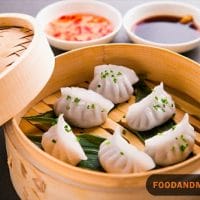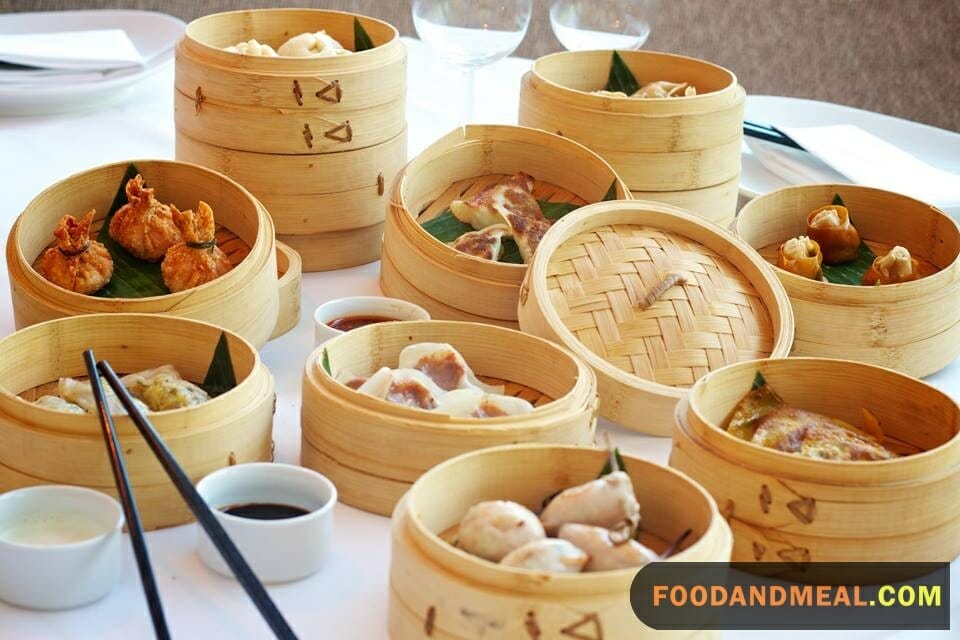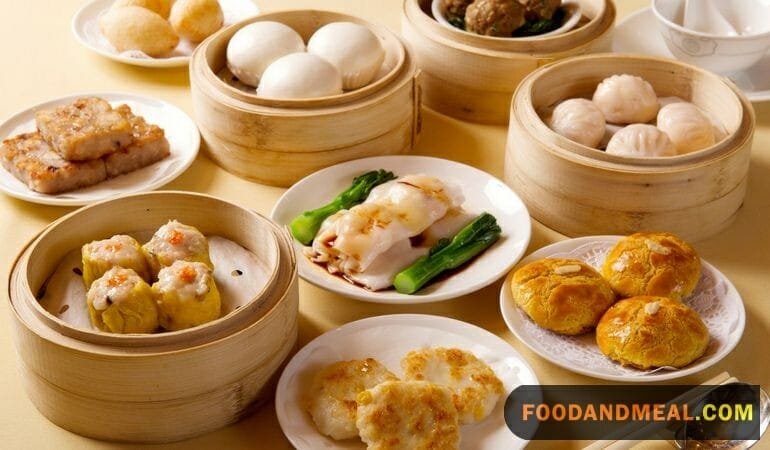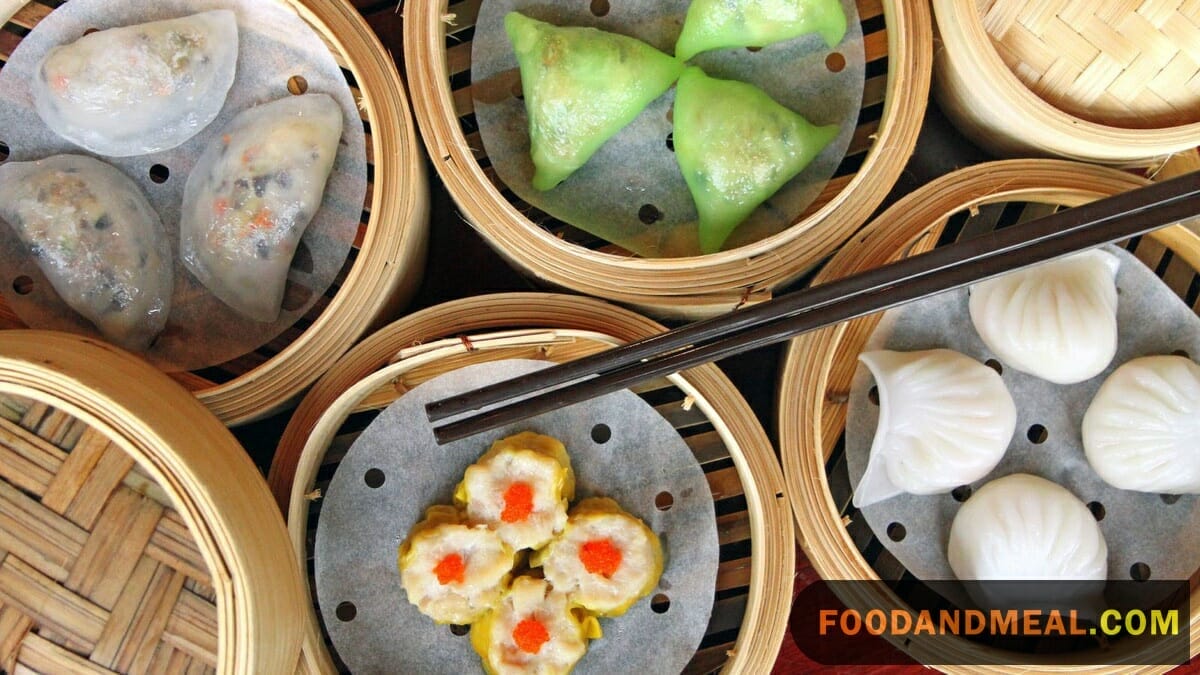My name is Nazia and I’m excited to share a new dim sum recipe with you today. As someone who loves exploring different cuisines, I recently tried these Dim Sum Thai steamed buns called salapao and fell in love with the sweet and savory flavors.
The delicately soft buns with the rich, aromatic filling reminded me of the dim sum dishes I enjoy when going out for yum cha. I decided to try making my own version at home using some Thai influences. While traditional salapao filling often contains pork or chicken, I opted to make a vegetarian version with tofu and mushrooms to better suit my dietary preferences.
I wanted to recreate those wonderful flavors and textures I had tried before while also putting my own spin on the dish. Cooking always relaxes me after a long day, and I find kneading the dough for these buns to be very therapeutic. I hope you’ll enjoy this Thai-inspired take on steamed buns as much as my family and I do. The recipe I’ll be sharing today puts a flavorful, meatless twist on a classic dim sum bun.
Introduction to Dim Sum Thai Steamed Buns
Dim Sum Thai Steamed Buns, to me, are like little pockets of joy that embody the beautiful amalgamation of Thai and traditional dim sum flavors. This culinary creation invites a gentle and soothing experience, making it more than just a dish—it’s a delightful journey through textures and tastes.
The process of crafting these buns begins with a simple yet magical combination of all-purpose and whole wheat flours, yeast, and a hint of sugar. Watching the dough rise over time feels like witnessing a small transformation, a quiet anticipation of the comforting bites to come.
As the whole wheat dough joins the party, the kitchen fills with the aroma of homey goodness. Kneading the dough becomes a therapeutic exercise, a mindful connection with the ingredients that promises a soft and yielding end result.
The vegetable filling, dressed in soy sauce, chili vinegar, sugar, and salt, introduces a burst of Thai character. Chopping the vibrant vegetables becomes a meditative act, each slice contributing to the overall harmony of flavors.
Shaping the dough with a touch of oil feels like sculpting a piece of culinary art. Baking the buns adds a subtle crispness, creating a delicate contrast to the impending pillowy softness.
And then comes the magical moment of steaming—the final touch that transforms these buns into a cloud-like indulgence. The gentle steam releases a captivating aroma, beckoning with promises of warmth and satisfaction.
In my personal culinary journey, Dim Sum Thai Steamed Buns represent more than just a recipe; they’re a reminder that joy can be found in the simplicity of creating something with your hands, savoring each step as it unfolds. Pairing these buns with a crisp salad completes the experience, offering a balance that makes every bite a moment of pure contentment.

Delicious dim sum recipes

Dim Sum (Thai Steamed Buns) Recipe
PrintIngredients
- 1/2 pound Ground pork
- 1 tablespoon Thin soy sauce
- 1/2 tablespoon Thai pepper powder
- 1 tablespoon Sugar
- 1 tablespoon Garlic powder
- 1/2 tablespoon Fresh shallot
- 1 cup Milk
- 1 tablespoon Vegetable oil
- 1 cup All-purpose flour
- 1/2 cup Whole wheat flour
- Salt, to taste
- Water, to kneed
- 1 Cucumber
- 1 cup Yeast
Instructions
- Take a bowl and add the flour into it.
- Then add the yeast and sugar into it.
- Add lukewarm water in it.
- Set aside for half an hour.
- In another bowl, take the whole wheat flour.
- Add the yeast dough in it.
- Then add the salt and some water in it.
- Then combine the ingredients to form a soft dough.
- Kneed it for ten minutes.
- Meanwhile, chop all the vegetables.
- Mix them with soy sauce, chili vinegar, sugar and salt.
- Make round forms of dough with the help of the oil.
- Then bake your buns for ten minutes.
- Once the buns are steamed, take them out.
- You can serve Thai buns with salad.
Video
Notes
Nutrition
© Food And Meal
This website provides approximate nutrition information for convenience and as a courtesy only. Nutrition data is gathered primarily from the Spoonacular Database, whenever available, or otherwise other online calculators.
Cooking Tips: pork buns

First, make sure your dough has enough gluten development by kneading it thoroughly. I find that spending a few extra minutes working the dough makes it easier to handle when forming the buns and gives a nice soft yet chewy texture after steaming. Take your time during this step and don’t rush it.
Next, when making the filling, be sure to squeeze out as much liquid from the tofu and mushrooms as possible before mixing everything together. Too much moisture in the filling will make the buns soggy. I like to let the filling cool completely before assembling the buns so that it firms up a bit.
Shaping the dough around the filling takes some practice. Don’t worry if your buns look a little wonky at first! As long as you seal the dough well, they’ll still taste delicious. I pinch the edges together firmly and try to smooth the top a bit for a nicer presentation.
Finally, when it comes time to steam, make sure not to open the lid at all during steaming. This allows the buns to cook evenly. And be patient – steaming for full 10-12 minutes ensures the dough is fully cooked through.
Serving Suggestions

These Thai-inspired steamed buns would pair deliciously with a variety of Asian dishes. For a light meal, I suggest serving them alongside a Thai chicken pad thai or a refreshing pineapple or blueberry ice cream for dessert. The sweet and tangy fruits would contrast nicely with the savory, aromatic buns.
For heartier fare, the steamed buns could accompany a rice-based dish like Thai sweet rice cakes. Their soft, chewy textures would complement each other well. Braised chicken and potatoes or a Japanese hot pot with meat or vegetables would also make satisfying choices.
No matter what you choose to serve alongside these steamed buns, the possibilities are diverse. Feel free to get creative with complementary flavors and textures that appeal to your personal tastes. The adaptability of this steamed bun recipe truly lends itself to a variety of culinary traditions beyond dim sum.
FAQs of Dim Sum

- Can I Freeze Uncooked Buns? Absolutely! After assembling the buns, place them on a baking sheet and freeze until firm. Then, transfer to an airtight container. When ready to enjoy, steam the frozen buns for a few extra minutes.
- Why Did My Buns Collapse? Buns collapsing during steaming could be due to overproofing. Ensure that the dough rises just until doubled in size, not more, before shaping and steaming.
- Can I Use Different Fillings? Certainly! Dim Sum Thai Steamed Buns are highly customizable. Experiment with sweet or savory fillings like BBQ pork, mushrooms, or custard for a diverse spread.
- How Do I Reheat Leftover Buns? To reheat leftover buns, steam them for a few minutes until they’re warmed through. This process helps restore their soft texture and fresh flavors.
- How Can I Store Leftover Buns? Store leftover steamed buns in an airtight container in the refrigerator for up to 2 days. For longer storage, freeze them and follow the reheating instructions mentioned above.
- What is the difference between steamed buns and steamed dumplings? Steamed buns (Baozi): Soft, fluffy bread-like dough filled with various ingredients, often meat or vegetables. Steamed dumplings: Dumplings typically have a thinner dough and are filled with various ingredients, usually a mix of meat and vegetables.
- What is the difference between steamed bun and bao bun? Steamed bun and bao bun are often used interchangeably. “Bao” is a Chinese term that translates to “bun.” Steamed buns, including bao buns, can have a variety of fillings and are a staple in Chinese cuisine.
- Is dim sum like bao buns? Dim sum is a broad category of Chinese dishes, and bao buns are a specific type of dim sum. Dim sum refers to a variety of bite-sized dishes, including dumplings, buns, and more. Bao buns are a subset of dim sum, specifically referring to the steamed buns filled with savory or sweet fillings.
- What is the difference between bao and gua bao? Bao: A generic term for buns in Chinese cuisine. Gua Bao: Refers to a specific type of bao bun that is folded and typically filled with braised pork belly, along with condiments like pickled mustard greens and ground peanuts.
Conclusion
In conclusion, I hope you’ll give these Thai-inspired dim sum buns a try soon. This recipe from Food And Meal puts a flavorful spin on the classic steamed bun while being approachable for home cooks. The vegetarian filling and kneaded dough make for a soothing cooking project that results in deliciously comforting food.
As someone passionate about exploring new cuisines, I love putting my own twist on dishes while respecting their cultural roots. These buns allow me to showcase both Thai and Chinese influences in an appetizing way.
Head over to the Food And Meal website for the full recipe details as well as more of my favorite Asian-inspired meals. I find cooking to be a wonderful creative outlet, and I’m happy to be sharing that joy through my recipes on Food And Meal. Let me know how your homemade dim sum buns turn out!
Hi! I'm Nazia of ‘Nazia Cooks’, a self-taught baker and cook residing in Chennai. Rooted in the rich South Indian culinary landscape, my palate has expanded to embrace global flavors. I revel in crafting fusion dishes, melding traditions to birth unique tastes.


